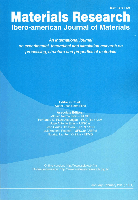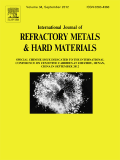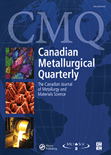
Korean Journal of Metals and Materials
Scope & Guideline
Connecting Researchers in the World of Metals and Materials
Introduction
Aims and Scopes
- Materials Characterization:
The journal publishes research involving various techniques for the characterization of materials, including microstructural analysis, mechanical testing, and thermoelectric properties. - Advanced Manufacturing Techniques:
There is a strong emphasis on innovative manufacturing processes such as additive manufacturing, casting, welding, and sintering, aiming to improve material performance and production efficiency. - Nanomaterials and Nanotechnology:
The journal frequently features studies on the synthesis, characterization, and applications of nanomaterials, highlighting their potential in electronics, energy storage, and catalysis. - Corrosion and Surface Engineering:
Research on the corrosion behavior of metals and alloys, along with surface modification techniques to enhance material durability, is a consistent focus area. - Thermal and Mechanical Properties:
The journal covers studies that investigate the thermal and mechanical properties of various materials, particularly under extreme conditions, to understand their performance in practical applications. - Functional Materials:
There is a notable interest in the development of functional materials, including thermoelectric materials, magnetic materials, and electronic components, aimed at specific technological applications. - Sustainability and Recycling:
The journal promotes research on sustainable practices in materials science, including recycling processes and the development of eco-friendly materials.
Trending and Emerging
- Thermoelectric Materials:
There is a growing interest in thermoelectric materials research, focusing on improving their efficiency and applications in energy conversion and cooling technologies. - Machine Learning and Data Science Applications:
The integration of machine learning and data science techniques in materials research is on the rise, facilitating predictive modeling and optimization of material properties. - Sustainable Materials and Recycling Technologies:
Research on sustainable materials, including bio-based and recyclable materials, is gaining momentum as industries seek greener alternatives to traditional materials. - 3D Printing and Additive Manufacturing:
The journal is witnessing an increasing number of studies on additive manufacturing technologies, emphasizing their potential for producing complex geometries and tailored material properties. - Nanostructured Materials:
The trend towards nanostructured materials continues to grow, with research focused on their unique properties and applications in electronics, medicine, and energy. - Smart and Functional Coatings:
Emerging research on smart coatings that respond to environmental stimuli is becoming more prominent, highlighting advancements in surface engineering. - Electrochemical Systems and Energy Storage:
Research in electrochemical systems, particularly related to batteries and supercapacitors, is trending as the demand for efficient energy storage solutions increases.
Declining or Waning
- Traditional Metallurgy:
Research focusing on traditional metallurgy practices and processes has seen a decrease, possibly due to the growing interest in advanced materials and innovative manufacturing techniques. - Conventional Alloy Development:
There is a waning interest in the development of conventional alloys, as the focus shifts towards high-performance materials and alloys with specialized properties for modern applications. - Basic Material Science:
While foundational studies in material science remain important, there has been a noticeable decline in papers that primarily focus on basic material properties without application-oriented research. - Static Mechanical Testing:
Research centered solely on static mechanical testing, without consideration of other influencing factors such as microstructure or processing techniques, appears to be declining.
Similar Journals

Materials Research-Ibero-american Journal of Materials
Empowering researchers with open access to cutting-edge insights.Materials Research-Ibero-american Journal of Materials, published by the UNIV FED SAO CARLOS, DEPT ENGENHARIA MATERIALS, is a prominent platform dedicated to advancing the field of materials science. Launched in 1998, this Open Access journal has fostered a culture of inclusive knowledge sharing, allowing researchers and practitioners worldwide to access valuable insights in Condensed Matter Physics, Materials Science, Mechanical Engineering, and Mechanics of Materials. With a commendable Q3 ranking in these diverse categories in 2023, the journal provides a vital resource that bridges theoretical research and practical applications in materials technology. Covering a range of topics from novel material characterization to innovative engineering solutions, Materials Research serves as a critical forum for contributors across the globe, particularly those in Latin America. Researchers, students, and professionals are encouraged to engage with this journal, which operates with a clear commitment to high standards and is based in São Carlos, Brazil, further enhancing its relevance and appeal within the international materials research community.

METALS AND MATERIALS INTERNATIONAL
Driving excellence in materials research since 1996.METALS AND MATERIALS INTERNATIONAL, published by the Korean Institute of Metals and Materials, is a prestigious journal dedicated to the advancement of research in the fields of materials science and engineering. With an ISSN of 1598-9623 and a robust e-ISSN of 2005-4149, this journal has established itself as a crucial platform for disseminating innovative findings and key advancements that span condensed matter physics, materials chemistry, mechanics of materials, and the technology of metals and alloys. Its Q1 rankings in multiple categories attest to its high impact and relevance in the academic community, placing it among the top journals in its fields with Scopus rankings that reflect a strong international footprint. Here, researchers, professionals, and students can access cutting-edge research and insights, fostering collaboration and exploration of new materials and their applications. With a commitment to excellence and a convergence of knowledge from 1996 to 2024, METALS AND MATERIALS INTERNATIONAL continues to enhance our understanding of materials and their transformative impact on technology and engineering.

Materials Research Express
Championing open-access research for all materials enthusiasts.Materials Research Express is a leading open-access journal published by IOP Publishing Ltd, situated in the United Kingdom. Since its establishment in 2014, the journal has become an essential platform for researchers and professionals in the field of materials science, spanning several critical domains including biomaterials, metals and alloys, polymers, and electronic materials. With an open-access model adopted in 2020, Materials Research Express ensures that cutting-edge research is accessible to a global audience, enriching the dissemination of knowledge within the scientific community. The journal boasts impressive Scopus rankings, with a commendable position in various categories, such as 45th in Metals and Alloys and 51st in Surfaces, Coatings, and Films. This positions it well in the competitive landscape of materials science, fostering innovative discussions on material properties and applications. As the field continues to evolve, Materials Research Express aims to provide high-quality research and insights that address contemporary challenges and emerging technologies, making it an indispensable resource for academics and industry professionals alike.

Journal of Metals Materials and Minerals
Pioneering Research in Metallurgical Science and EngineeringJournal of Metals Materials and Minerals (ISSN: 0857-6149) is a renowned academic publication dedicated to the interdisciplinary fields of metallurgical science, materials engineering, and mineralogy. Published by Chulalongkorn University, Metallurgy & Materials Science Research Institute in Thailand, this journal serves as a pivotal platform for researchers to disseminate their findings and explore innovative applications related to metals, ceramics, polymers, and biomaterials. Although the journal does not currently adopt an open-access model, it provides insightful content that facilitates knowledge sharing among professionals and academics alike. The journal has established its credibility with impressive Scopus ranking percentiles, particularly in categories such as Metals and Alloys and Ceramics and Composites. With an emphasis on advancing the understanding of materials science from 2017 to 2024, the Journal of Metals Materials and Minerals remains an essential resource for those striving to contribute to and stay informed about the latest trends and breakthroughs in these dynamic fields.

Acta Metallurgica Slovaca
Championing open access to transformative metallurgical insights.Acta Metallurgica Slovaca is a distinguished open-access journal published by SCICELL SRO that has been pivotal in the field of Materials Science and Metallurgy since its inception. With a robust commitment to disseminating high-quality research, this journal covers a wide array of topics within the scope of metals and alloys. Now indexed in Scopus, it ranks 82nd out of 176 in its category, reflecting a growing influence within the scientific community. With a quartile ranking of Q3 as of 2023, Acta Metallurgica Slovaca serves as an essential platform for researchers and professionals seeking to share innovative findings and developments in metallurgical science. Open access since 2013, it ensures that research is accessible to all, fostering collaboration and engagement across academia and industry worldwide. With a converged publication timeline extending from 2009 to 2024, this journal continues to play a crucial role in advancing knowledge and addressing contemporary challenges in the metallurgy sector.

Russian Journal of Non-Ferrous Metals
Pioneering Research in Surface EngineeringThe Russian Journal of Non-Ferrous Metals, published by PLEIADES PUBLISHING INC, serves as a vital resource for researchers and professionals in the fields of materials science and engineering. With a dual ISSN (1067-8212 for print and 1934-970X for online), this journal has been instrumental in disseminating cutting-edge research from 2007 to 2023. Specializing in the mechanics of materials, metals and alloys, and the study of surfaces, coatings, and films, it provides invaluable insights into the latest advancements and applications in these areas. Although currently categorized in the Q4 tier for mechanics of materials and surfaces, and Q3 for metals and alloys in the 2023 rankings, its commitment to quality research is reflected in its Scopus metrics, ranking it within the competitive spectrum of its fields. While not an open access journal, it remains a crucial academic platform for fostering knowledge exchange among professionals and scholars. By publishing high-quality articles, the Russian Journal of Non-Ferrous Metals contributes significantly to the ongoing dialogue in metallurgical science and engineering.

INTERNATIONAL JOURNAL OF REFRACTORY METALS & HARD MATERIALS
Leading the way in high-impact materials research.INTERNATIONAL JOURNAL OF REFRACTORY METALS & HARD MATERIALS, an esteemed publication by Elsevier Science Ltd, stands at the forefront of materials research, focusing on the development and application of refractory metals and hard materials in various engineering fields. With an impressive impact factor and recognition as a Q1 journal across several categories including Ceramics and Composites, Materials Chemistry, and Mechanical Engineering, it serves as a vital resource for researchers, professionals, and students alike. The journal has been continuously publishing high-quality research since its inception in 1982, with a convergence of developments spanning through to 2024. Its Scopus rankings further emphasize its significance, boasting ranks in the top percentiles of relevant scientific fields. Although it operates under a subscription model, the depth and rigor of the research published within its pages ensures that it remains an invaluable tool for those pursuing innovation and exploration in materials science.

SURFACE REVIEW AND LETTERS
Empowering Researchers with Timely InsightsSURFACE REVIEW AND LETTERS, published by WORLD SCIENTIFIC PUBL CO PTE LTD, is a pivotal journal in the fields of condensed matter physics, materials chemistry, and surfaces and interfaces. With an ISSN of 0218-625X and an E-ISSN of 1793-6667, this journal serves as a platform for cutting-edge research and innovative developments from 1996 to 2024. Despite its classification in the Q4 and Q3 quartiles for various categories in 2023, SURFACE REVIEW AND LETTERS emphasizes the importance of inter-disciplinary collaboration and the rapid dissemination of valuable insights, making it an essential resource for researchers and professionals eager to stay at the forefront of material science. Although currently lacking an open access option, the journal invites a wide range of submissions—fostering knowledge sharing among scholars and contributing to the advancement of the scientific community. Aspiring authors and readers will benefit from the opportunity to engage with diverse studies and methodologies, underscoring the journal's commitment to excellence in materials research.

SURFACE ENGINEERING AND APPLIED ELECTROCHEMISTRY
Bridging Theory and Practice in Surface EngineeringSURFACE ENGINEERING AND APPLIED ELECTROCHEMISTRY, published by PLEIADES PUBLISHING INC, stands as a pivotal resource in the realms of engineering and materials science. With an ISSN of 1068-3755 and an E-ISSN of 1934-8002, this journal encompasses an extensive scope that includes industrial applications, and innovative surface treatments, fostering advancements in the fields of Industrial and Manufacturing Engineering, Surfaces, Coatings and Films, and Surfaces and Interfaces. Recognized for its contributions, it currently holds a Q3 classification in both Industrial and Manufacturing Engineering and Surfaces, Coatings and Films, alongside a Q4 ranking in Surfaces and Interfaces for the year 2023. Despite its competitive standings, the journal encourages inclusive dialogue and dissemination of research from a global community—making it an essential platform for researchers and professionals dedicated to surface technologies and applied electrochemistry. Potential contributors and readers can expect a comprehensive exploration of techniques and innovations, reinforcing the journal's commitment to bridging theory and practical application in these dynamic fields.

CANADIAN METALLURGICAL QUARTERLY
Advancing Metallurgical Knowledge, One Quarter at a Time.Canadian Metallurgical Quarterly is a prestigious scholarly journal published by Taylor & Francis Ltd, dedicated to the field of metallurgical engineering and materials science. With a rich history dating back to its inception in 1962 and continuing through its most recent publications, this journal serves as a vital platform for the dissemination of innovative research, advancements, and critical reviews in metallurgy, metals, and alloys. Positioned strategically within the academic community, it holds a significant impact factor and is currently rated in the Q2 category for Metals and Alloys, and Q3 in Industrial and Manufacturing Engineering as of 2023, showcasing its authoritative role in these disciplines. Although it does not offer open access, the journal remains widely recognized for its rigorous peer-review process, ensuring that published work adheres to the highest standards of scientific quality. Researchers, professionals, and students alike will find invaluable insights and contributions that drive the field forward.